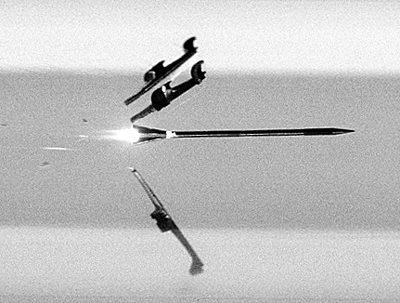We’ve covered the sheer destruction that railguns can unleash before here on the Gizmo-Teched but they only have been firing what have been called “hypersonic bricks”. Although these bricks can already do a lot of damage, but defense contractor General Atomics is looking for something even better. They, with the help of Boeing, created a new “sabot” round that will be aerodynamic and can punch a hole in a steel plate and can still travel for another 4 miles.
Now a sabot round is a military technical term for a device that used in a firearm (mainly tanks these days) to shoot a projectile that is a smaller diameter than the cannon itself. Specifically in today’s terms sabot rounds are used in tanks to penetrate targets with kinetic energy which if punctured will create heat and pressure waves thereby destroying the target. Other techniques used in tank rounds are chemical rounds such as high explosive anti-tank (HEAT) rounds. These use an explosive charge to create a high-velocity jet of plasma metal to punch through armor. Now while that may seem pretty good, they are several types of modern armor made to deflect these rounds and make them ineffective. That’s why many modern tanks today use armor-piercing discarding sabot (APDS) and armor-piercing fin-stabilized discarding sabot (APFSDS), that later is currently used in the US Army’s M1 Abram.
APFSDS rounds, also known as kinetic energy penetrators, work through the principle of the kinetic energy: mass and velocity. The main idea of kinetic energy weapons is to maximize kinetic energy and minimize the area which it is delivered to. It can do this through various techniques such as being fired with a very high exit velocity, concentrating its force to a very small impact area yet still retaining a relatively large mass, and finally maximizing the mass of the projectile. To achieve the later technique, dense metals are often used, which is why sometimes depleted uranium rounds are employed.
Theoretically, the best design for a KE penetrator would be a long, thin rod, sort of like an arrow. However, rods are characteristically unstable during flight and tend tumble, thus making it not that accurate. In addition, shells, such as those in artillery, in past have been given inflight stability through rifling which gives the round a spin. However, this is not affective with rounds that are much longer than the diameter of the barrel. The solution would be to add fins, just like the base of an arrow. Rifling also decreases the effectiveness of penetrate of KE penetrator rounds by taking away from the linear energy by rotational energy. This why arms that use APFSDS rounds use smoothbore guns, which are guns that don’t have rifled barrel. In addition most modern tanks use smoothbore guns because rifling takes away from the effectiveness of HEAT rounds as well.
Ok enough background info, back to the new railgun round. So after the some initial testing at Dugway Proving Grounds (a US army testing facility near Salt Lake City) after “launching hypersonic bricks at Mach 5, Mach 6,”the guys from General Atomics were confident that the railgun was operationally. According to Defense Tech, these “hypersonic bricks” were not that aerodynamic and occasionally tumbled out of control. The more aerodynamic round is a sabot which consists of a three part system. The first is the armature which is used to propel the round out of the barrel of the gun. This doesn’t include the any propellant used to move the round but instead is to help push it with the force of the railgun. The second piece is the fin component of the sabot which is used to keep the round stable in the round as well as in the air. Once the sabot has left the barrel, the fins separate and the penetrating part of the round is remaining. During testing the round was fired at zero gun elevation (zero degrees of elevation) and traveled at about 1600 meters per second. Even after punching through a solid steel plate 100 meters downrange, the round traveled for another 7km!
General Atomics is planning on putting this beast of gun on the Navy’s DDG-51 destroyers. Already in the talks, they plan on having a demo of the weapon at sea within 4 years and then in production and on the battlefield within 3. Being able to punch solid holes through ships is terrifying so I would hate to be on the business end of a railgun armed with these rounds.


 11:32 AM
11:32 AM
 Silver
Silver





0 comments:
Post a Comment